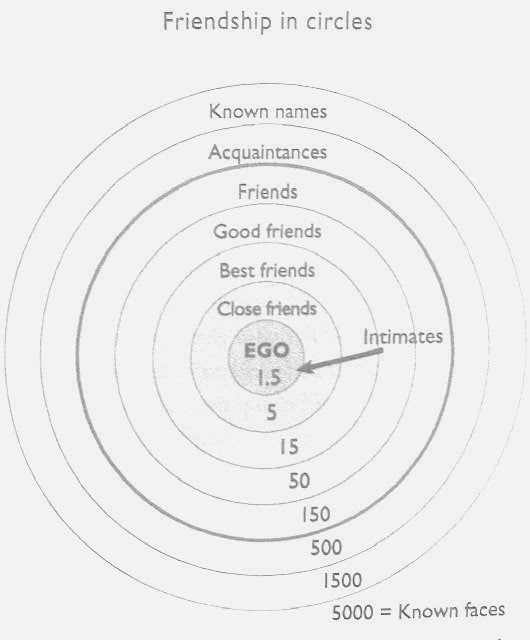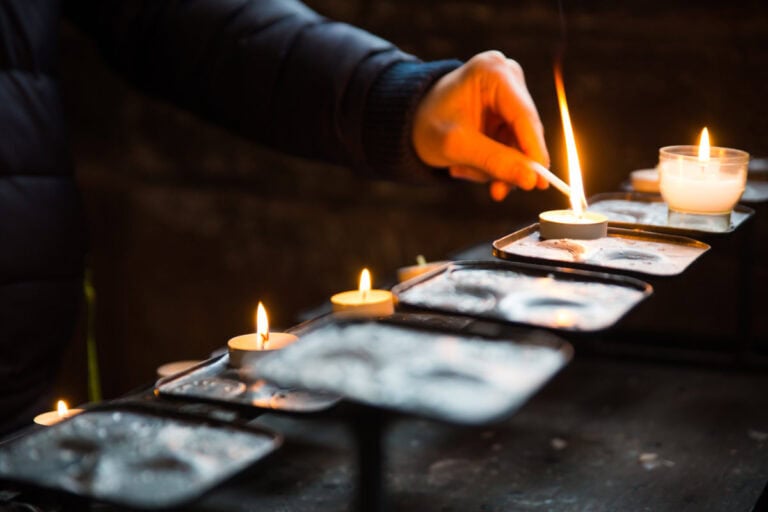Medical research has documented the value of friendships on health, well-being, and longevity. Loneliness turns out to be the modern killer disease, outranking and/or exacerbating the usual candidates. Inadequate or poor integration into your social network comes in behind only heart attacks and strokes in lethality. A strong social network increases survivability by 50%, equal to giving up smoking.
Besides the usual help, encouragement, and enjoyment that friendships bring, research suggests that endorphins released by the presence of friends tunes the immune system to enhance resistance to a variety of ailments. In spiritual circles, we often use the word ‘community’ as a synonym for the close network of people with whom we pray, worship, and serve. As we focus more liturgically, I will use the terms ensemble and choir interchangeably for we who lead the assembly in music.
The structure of friendships
You may be familiar with Dunbar’s Number. People who study social networks say that the average size of a friendship network (the dividing line between friends and acquaintances) is about 150+/–. This is a natural group size in human communities gleaned from a wide variety of research done across the world.
There are small but consistent fluctuations in that number based on personality, sex, and age:
- Younger people tend to have more friends (which some believe is explained by youngers being less discriminating in friend selection.)
- Extroverts tend to have slightly more friends than introverts (though introverts think that while they have fewer friends, the relationships run deeper.)
- Women have more friends than men.
- Night owls tend to have larger social networks than early birds.
Within one’s social network, usually about 70% are of your own gender. Circles of friendship expand by roughly three times at each level of friendship.

Graphic from Robin Dunbar’s excellent book: “Friends: Understanding the Power of our Most Important Relationships” published in 2021. See page 71 for this graph.
The seven pillars of friendship
Dunbar identifies seven pillars of friendship:
- Having the same language or dialect
- Growing up in the same location
- Having the same educational and career experiences
- Having the same hobbies and interests
- Having the same worldview (an amalgam of moral views, religious views, and political views)
- Having the same sense of humor
- Having the same musical tastes
The more of these pillars we have in common with someone, the more time we’re prepared to invest in them, the more emotionally close we feel towards them, the closer they will be to us in the layers of our social network, and the more willing we will be to help them out when they need it. And, the more likely they are to help us. Birds of a feather really do flock together. We tend to gravitate towards people with whom we have more things in common. A common faith is an important pillar, but friendships are defined by more than that. Within our choirs, there will be some with whom we bond more readily and some less given the interplay of these factors.
We tend to like the people more who are more like us. In fact, each layer of your social network is equivalent to a particular number of ‘pillars’ shared – six or seven for the innermost five-person layer, just one or two at the outer 150 person layer. It doesn’t seem to matter which ones are actually shared in common, no hierarchy or preference. A three-pillar friend is a three-pillar friend irrespective of which three pillars are in common.
Building and maintaining friendships
When you think about your ensemble, most of those I’ve encountered are from 5 to 15 to 45, depending on the size of the parish, support from the pastor, organizational elements, etc. Not all your ensemble mates are going to be five- or six-pillar friends, but the community that is the ensemble within the larger community of the parish share many of those elements of the inner circles.
The process of making a new friend follows a fairly set pattern. When we first meet someone new we invest a fair amount of time in them as we discern (often at a subconscious level) which pillars we share in common. It takes time but once we have a sense of it, we reduce the time we devote to them to a level appropriate to the number of pillars we have in common. As a result, they quietly slide back down through the layers to settle out in the layer appropriate to the number. In our ensembles, this might look like settling into good working relationships amongst our singing and playing together ministry.
Friendship (not to mention being in community) is a two-way street, requiring both parties to be reasonably accommodating and tolerant of each other. When friendships end, they typically die in one of two ways – by gradually fading out or by cataclysmic collapse. Old friendships may fade as circumstances change and they are replaced by new friendships, like leaving high school to go to college, moving for job or family, retirement, etc. Friendships often die when we don’t see the people often enough to maintain the relationship.
Cataclysmic endings are often associated with very close relationships, inner circle, romantic partners, etc. In my years leading Loose@9 (the ensemble at St. Michael’s), I saw some of each. Some folks fade out, some folks leave angry or upset — I’ve seen both door slamming and tantrums. Some folks come in ready to meet everyone as long-lost friends and hit the ground running. Others come in quietly and prefer to get a sense of the group’s culture and ways of doing things, not to mention seeing if it is going to be a safe place to join in.
The six key rules for maintaining a stable relationship:
- Standing up for the friend in their absence
- Sharing important news with a friend
- Providing emotional support when it’s needed
- Trusting and confiding in each other
- Volunteering help when it is required
- Making an effort to make the other person happy
Breaking any of these rules seems to weaken the relationship, and breaking many often leads to a complete relationship breakdown.
Understanding relationship breakdowns
When people describe the causes of a relationship breakdown, the three most frequent causes were: perceived lack of caring, poor communication, and jealousy. Between them, these three seem to account for more than 50% of all cases of relationships breaking down. Breaches of trust figure prominently — the smaller the circle, the higher the level of trust. More trust increases a relationship’s resistance to a breach of trust, but bigger or more frequent breaches will destabilize it. The closer the relationship, the more terminal a de-friending may be in such cases. Often, family tends to be more forgiving (or tolerating?), perhaps because we are stuck with each other through kinship.
In our ensembles, expectations that don’t match reality are often a part of the relationship breaking down. Sometimes there’s a kind of performance mindset. I have seen people leave choir in a huff because they weren’t getting enough ‘solo’ time. Sometimes people have unfulfilled hopes that choir will satisfy needs rooted in anxiety or loneliness or other yearnings, perhaps without even being able to identify them. Sometimes people are focused on the community part and are put off by expectations around musicianship and reliability that may exceed talent or ability to learn. (If you are tone deaf and loud, choir may not be the ministry for you!) There is always a bit of trial and error in the search for a group that is a match and provides the sense of belonging we all want and need.
In the wider picture, when it comes to relationship breakdowns in general, a noticeable gender difference shows up in the research. Men tend to mention drifting apart, problems with alcohol or drugs, and competition from rivals and others stirring things up. Women are more likely to mention poor communication, jealousy, and tiredness making them less caring (which sounds a lot like burnout.)
Another noticeable trend is where men tend to blame others, women tend to blame themselves. One of the challenges in very close relationships such as romantic ones, is that each gender may well come to the relationship with different expectations. There is a perception that women have higher expectations with regard to reciprocity (of loyalty, trustworthiness, mutual regard and support), genuineness, and communion (willingness to engage in self-disclosure and intimacy). Men, in contrast, seem to have higher expectations in regards to physical activities and striving for status. Stylistically, men may seem more confrontational, inclined more to joke at another’s expense, and show more attempts to score points over each other in a way perceived by them to be friendly but by women as threatening or even intentionally aggressive.
Close family or romantic relationships are the ones most at risk of ending catastrophically, and are the most difficult to reconcile precisely because they may end with an acrimonious rupture. A rule of thumb is that if a reconciliation is going to happen, it is within the first few weeks after the breakdown. Otherwise, it becomes semi-permanent with neither side being prepared to initiate the process of reconciliation.
Embracing the value of friendships
So, tending your friendship garden is as important for your physical as your emotional and spiritual health and well-being. Water it regularly through mindful connection, attention, curiosity, and quality listening. Your life may depend on it. Your community certainly needs it.
Written by Ken Gilman, a retired music director and an obbligatist on a variety of instruments – mandolin, bouzouki, violin, octave viola, bass mandolin, etc. As a semi-retired psychologist and mediator, he works with first responders on topics of teamwork, communication, and burnout.
Copyright © 2025 Catholic Liturgical Ensemble Formation
Looking for more resources? Search our full online library of CLEF Life resources, or sign up for CLEF Life email updates to receive the latest resource in your inbox once a week.



